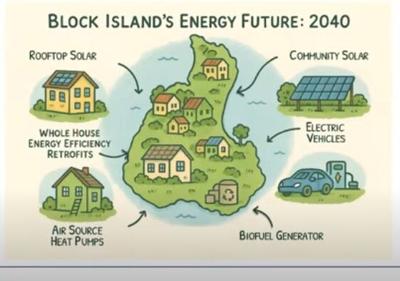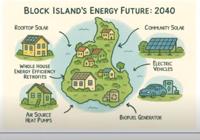Peter Cappers of the U.S. Department of Energy’s Office of Energy Efficiency and Renewable Energy gave his final presentation to the Block Island community on the results of the ETIPP study done on behalf of the Block Island Utility District on May 20.
ETIPP stands for Energy Technology Innovation Partnership Project, which seeks to increase the energy resilience in coastal, remote, and island communities. Cappers, who works out of the Lawrence Berkeley National Lab, told the crowd at Town Hall that ETIPP “provides help to communities that are charting their own course.”
This was the third public presentation by Cappers. The next and final step is for him to write up a full report.
BIUD President Jeffery Wright said, “It’s important for that report to stay front and center.” As it’s a “roadmap to 2040,” Wright said it was important that the report be available as there is future turnover in the Board of Commissioners and staff.
Of the study, Wright said, “It affirmed some things I knew and helped open my eyes to some other possibilities, but I really like the results and am excited to hear what you have to say.”
“Ultimately, my goal here is for you to all walk away with a better sense of, based on the objectives you all talked to me about, the Block Island Utility District talked about. Hopefully, you walk away with a sense of, okay, what could 2040 look like and how do we make some trade-offs around what the future could look like. You’re a cooperative utility and ultimately you get to decide what direction to take that utility in.”
The final report won’t be an absolute. There are options to be considered along with those trade-offs, and there are constraints, whether those be at the federal, state, or local level. For instance, federal regulations prohibit a utility from being both a producer of energy, and a distributor of energy. Block Island was exempt from that before the undersea transmission cable was installed in 2017 and produced its own energy with diesel generators that burned about a million gallons per year.
Although the Block Island Utility District has received permission from the state to retain and utilize those generators for back-up generation in the case of a cable outage, returning to burning expensive diesel is not ideal. That’s where ETIPP comes in. The road map isn’t meant to provide a plan for Block Island to once again provide all of its own power at all times, only in the event of an emergency. Still, the dependence on the cable could be lessened with a greater mix of renewable energy that is produced on the island.
As he has before, Cappers started of with a lesson on how the electric grid works with the over-riding lesson that supply must equal demand at all times so there is a constant dance for grid operators to manage energy inputs to meet demand at different times of day, and at different times of the year.
It’s no different on Block Island. With power coming through the cable, the situation is fairly manageable, but when on-island generated electricity comes into the mix, things get complicated. For instance, on Block Island, the emphasis is on solar energy and many people have roof-top solar systems for which they are credited for the excess energy they produce. However, Block Island’s energy needs tend to peak in the evening, especially in the summer, when the sun is not shining. In the winter, energy needs are low, and again, if there are too many solar installations there may be excess energy. Uncertainty, Cappers said, leads to more challenges.
Another constraint is that Block Is- land can’t send any of that excess energy through the cable and back to the mainland. The cable was installed in conjunction with the Block Island Wind Farm and the developer has reserved all of the capacity for its own use.
So, Block Island needs to find a way to balance it all, and there are some options. Cappers presented a vision of the future that could include a mix of roof-top solar, community solar, and a biofuel project. That was included in the mix as the Utility District has been exploring the idea of a unit that could burn trash and turn it into energy without producing any negative outputs.
Cappers was quick to emphasize that Block Island would always need to get the majority of its energy from the cable and his analysis digs into how many hours per year could be 100-percent solar. But overall, the maximum over a year, considering patterns of seasonal and time of day usage, is about 45 percent.
As it is a road map to 2040, other assumptions need to be incorporated in the modeling such as what will the electric needs of the island be in 2040? There is the “status quo” scenario where people use about the same amounts of power as they do now, or there can be a more aggressive push for people to convert propane and diesel-burning appliances to electric, and to replace gas-powered vehicles with electric ones.
Last summer, the peak energy need on the island was about six megawatts. The off-season low is 1.5 megawatts. Under the status quo scenario, energy needs on the island are expected to rise to almost eight megawatts in the summer and under the more aggressive method, with “established goals,” energy needs could rise to almost 13 megawatts. What came as a surprise in the analysis was that under the more aggressive model, that peak of usage would occur in the winter rather than the summer.
Wright said those increases would affect the power substations also. Currently the Rhode Island Energy substation on the island has a rating of six megawatts, but that more can be produced if the company “turns the fans on.” Then, they can achieve a greater output, but not nearly enough to meet the goals under the more aggressive scenario, and expensive upgrades and another power conversion would need to be undertaken.
Although in the more aggressive scenario, the cost of power would go down because certain costs are spread among more usage, the ETIPP analysis did not account for the cost of capital upgrades.
When Cappers’s presentation was finished and he had answered a few questions, in closing, he not only thanked people for coming, but said, “You have no idea what it means to me seeing the same faces every time.”
The report will be available on the Block Island Utility District’s website when it is completed sometime this summer.


